...
Lecture notes are in PDF format
Return Return to home page
| Panel |
|---|
| bgColor | white |
|---|
| titleBGColor | cream |
|---|
|
| Background Color |
|---|
| Our Webinars (recordings) |
| Section |
|---|
| Column |
|---|
| | Panel |
|---|
| bgColor | white |
|---|
| title | Statistical postprocessing |
|---|
| 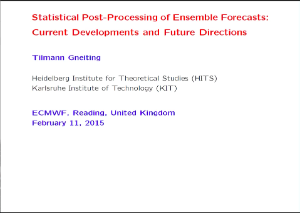
Statistical post-processing of ensemble weather forecasts: Current developments and future directions (Tilmann Gneiting) - Statistical post-processing techniques serve to improve the quality of numerical weather forecasts, as they seek to generate calibrated and sharp predictive distributions of future weather quantities and events. I will review the state of the art in post-processing, with focus on ensemble forecasts and ongoing joint work between the ECMWF and the Computational Statistics group at the Heidelberg Institute for Theoretical Studies (HITS). Current and future challenges include the treatment of extreme events, and the calibration of probabilistic forecasts of combined events and spatio-temporal weather trajectories, for which discrete copula based techniques, such as ensemble copula coupling (ECC) and the Schaake shuffle, are attractive options. . Click here to download the recording. |
|
| Column |
|---|
| | Panel |
|---|
| bgColor | white |
|---|
| title | Ensemble Data Assimilation |
|---|
| 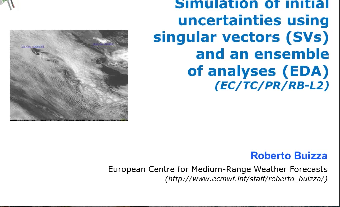
The aim of this webinar is to introduce the ECMWF ensemble of data assimilation (EDA). The rationale and methodology of the EDA will be illustrated, and its use in to simulate initial uncertainties in the ECMWF ensemble prediction system (ENS) will be presented.This webinar was delivered by Dr. Roberto Buizza and recorded in May 2014. Click here to download the recording. |
|
| Column |
|---|
| | Panel |
|---|
| bgColor | white |
|---|
| title | Multi-model ensemble predictions on seasonal timescale |
|---|
| 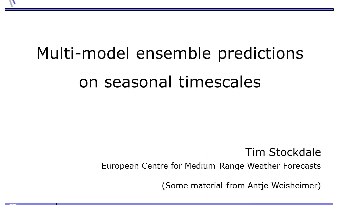
This lecture looks at calibration and multi-model ensembles from a seasonal forecasting perspective. The theoretical basis is given, followed by research results that strongly motivated a multi-model approach for these timescales. The operational EUROSIP multi-model system is described. This Webinar was delivered by Dr. Tim Stockdale and recorded in May 2014. Click here to download the recording. |
|
|
| Expand |
|---|
| title | CLICK HERE FOR MORE RECORDINGS..... |
|---|
| | Section |
|---|
| Column |
|---|
| | Panel |
|---|
| bgColor | white |
|---|
| title | Introduction to surface processes |
|---|
|  This Webinar was delivered by Dr. Gianpaolo Balsamo and recorded in May 2013. It is an introduction to surface processes that are relevant for NWP models. Click here to download the recording. |
|
| Column |
|---|
| | Panel |
|---|
| bgColor | white |
|---|
| title | Data assimilation of surface parameters (part 1) |
|---|
| 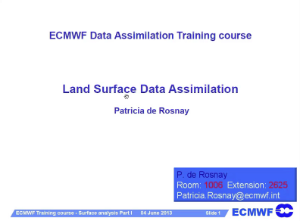 This webinar was delivered by Dr. Patricia De Rosnay and recorded in May 2013. It is the first of two webinars on Data Assimilation for surface parameters. It covers assimilation techniques used at ECMWF. Click here to download the recording. |
|
| Column |
|---|
| | Panel |
|---|
| bgColor | white |
|---|
| title | Data assimilation of surface parameters (part 2) |
|---|
| 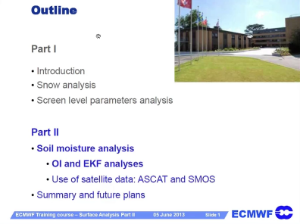 This webinar was delivered by Dr. Patricia De Rosnay and recorded in May 2013. It is the second of two webinars on Data Assimilation for surface parameters. It covers assimilation techniques used at ECMWF. Click here to download the recording. |
|
|
| Section |
|---|
| Column |
|---|
| | Panel |
|---|
| bgColor | white |
|---|
| title | Extra-tropical cyclones and their tracking |
|---|
| 
This Webinar was delivered by Mr. Tim Hewson and recorded in February 2015. The process by which extra tropical cyclones are identified and tracked in the ECMWF IFS analyses and forecasts will be described, and this will be followed by an overview of the multi-faceted web products that relate, and how to use them. Reference will also be made to objective fronts. Click here to download the recording (Lecture slides are available here) |
|
| Column |
|---|
| | Panel |
|---|
| bgColor | white |
|---|
| title | Monthly Forecast |
|---|
| 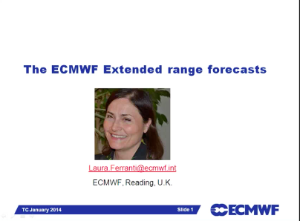
This Webinar was delivered by Dr. Laura Ferrati and recorded in February 2015. This presentation is an introduction to the ECMWF Extended range forecasts. The main sources of predictability at the sub-seasonal time scale will be introduced. The ECMWF forecasting system will be discussed as well as its products and its past performance. Click here to download the recording. (Lectures slides are available from here) |
|
| Column |
|---|
| | Panel |
|---|
| bgColor | white |
|---|
| title | Seasonal Forecast at ECMWF |
|---|
| 
This Webinar was delivered by Dr. Laura Ferrati and recorded in February 2013. It describes the Seasonal Forecasting system at ECMWF, its products and their interpretation. Click here to download the recording. |
|
|
| Section |
|---|
| Column |
|---|
| | Panel |
|---|
| bgColor | white |
|---|
| title | Coud and precipitation: from model to forecasting |
|---|
| 
This Webinar was delivered by Dr. Richard Forbes and recorded in February 2015. This seminar will describe how cloud and precipitation is represented in the ECMWF global model with examples of model evaluation against different types of observations and strengths and weaknesses highlighted. The cloud related forecast products are discussed with some insights into interpretation in different meteorological situations. By the end of this seminar you should be able to: 1. Describe how cloud and precipitation is represented in the ECMWF global model 2. Recognise some of the strengths and weaknesses of the forecast cloud/precipitation. 3. Interpret cloud and precipitation related forecast products. Click here to download the recording. (Lectures slides are available from here) |
|
| Column |
|---|
| | Panel |
|---|
| bgColor | white |
|---|
| title | Understanding the model climate |
|---|
| 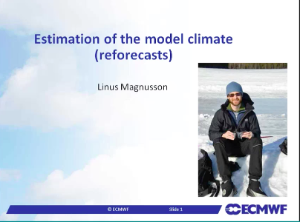
This Webinar was delivered by Dr. Linus Magnuson and recorded in February 2015. The aim the lecture is to give a motivation for why ECMWF produces a data set for the model climate, explain the configuration of it and discuss some of the strengths and weaknesses (limitations). In the lecture we will also explain the cumulative distribution function of the model climatology, as a background for the extreme forecast index (EFI). Click here to download the recording. (Lectures slides are available from here). |
|
| Column |
|---|
| | Panel |
|---|
| bgColor | white |
|---|
| title | Model errors and diagnostic tools |
|---|
| 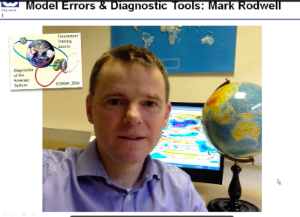
This webinar was delivered by Dr. Mark Rodwell and recorded in February 2015. Diagnostics at ECMWF is about looking for weaknesses in the forecasting system, trying to identify their causes, working with developers, and documenting the resulting changes in performance. As observation volumes increase, and models get more complex, accurate and represent smaller-scale weather features, and as the need for uncertainty information grows, diagnostic tools need to be ever more powerful and precise. Here, with the help of a few case studies, I will discuss the development of these tools, and how they are helping us identify residual deficiencies. Click here to download the recording. (Lectures slides are available from here). |
|
|
| Section |
|---|
| Column |
|---|
| | Panel |
|---|
| bgColor | white |
|---|
| title | Forecasting extreme events |
|---|
| 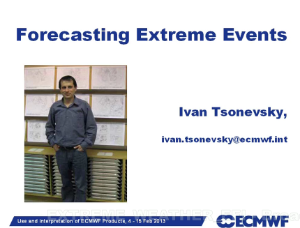 This webinar was delivered by Mr. Ivan Tsonevsky and recorded in February 2015. The Extreme Forecast Index (EFI) has been developed at ECMWF to alert forecasters to anomalous or extreme weather events by comparing the Ensemble Forecasts (ENS) with the model climate as a reference. The Shift Of Tails (SOT) was implemented in 2012 to complement the EFI by providing additional information about the extremity of a given weather event. This talk will give an overview of the use and interpretation of the EFI and SOT for forecasting extreme weather. It will provide information about some limitations of the EFI products and the future plans in the severe weather forecasting at ECMWF. A lot of practical examples will be used throughout the talk to explain and clarify different aspects of the EFI products in forecasting hazardous and anomalous weather events. Click here to download the recording. (Lectures slides are available from here). |
|
| Column |
|---|
| | Panel |
|---|
| bgColor | white |
|---|
| title | Sources of Uncertainties |
|---|
| 
The aim of this webinar is to introduce the main sources of uncertainty that lead to forecast errors. The weather prediction problem will be discussed, and stated it in terms of an appropriate probability density function (PDF). The concept of ensemble prediction based on a finite number of integration will be introduced, and the reason why it is to be the only feasible method to predict the PDF beyond the range of linear growth will be illustrated.This Webinar was delivered by Dr. Roberto Buizza and recorded in May 2014. Click here to download the recording. |
|
|
|
|
...